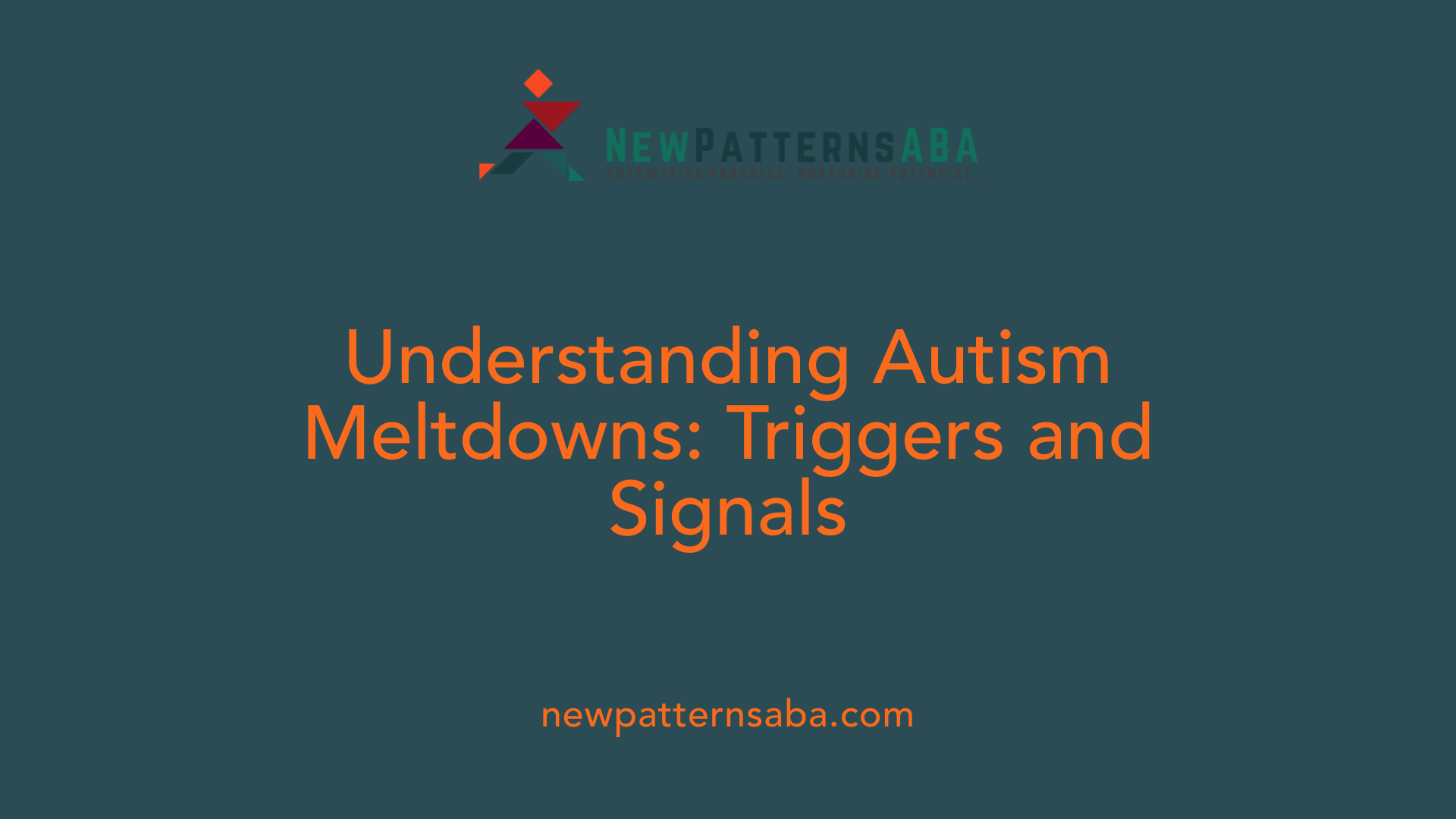Understanding and Managing Public Meltdowns with ABA Strategies
Navigating public settings with an autistic individual can be challenging, especially when meltdowns occur. Recognizing triggers, understanding the nature of meltdowns, and implementing evidence-based strategies like Applied Behavior Analysis (ABA) are key to ensuring safety and comfort. This article explores how caregivers, educators, and support networks can effectively manage and prevent meltdowns in public, emphasizing proactive planning, calming techniques, and collaborative interventions.
Understanding Meltdowns in Autism and Their Common Triggers

What are meltdowns in individuals with autism, and what are their common triggers?
Meltdowns in individuals with autism are intense, often uncontrollable reactions to overwhelming sensory, emotional, or cognitive stimuli. These episodes usually involve behaviors such as crying, screaming, flapping hands, or physical outbursts. Importantly, meltdowns are not deliberate or manipulative actions but are responses to feelings of being overwhelmed.
Individuals with autism can experience a range of triggers that lead to meltdowns. Common causes include sensory overload from bright lights, loud noises, or crowded spaces. Changes in routine or unexpected events can also increase stress and anxiety. Communication difficulties may prevent expressing needs, which adds to frustration. Fatigue, hunger, or emotional distress, such as feeling anxious or upset, further contribute to these episodes.
Recognizing early signs, like pacing, questioning, rocking, or withdrawal, can help in intervening before a meltdown escalates. Strategies such as creating a calm environment, using sensory tools, and maintaining consistent routines are effective in managing triggers. During a meltdown, staying calm, providing a safe and quiet space, and employing calming techniques are crucial for support.
Supporting individuals through their meltdowns involves empathy and understanding. Afterward, offering reassurance and helping them recover in a safe environment encourages better self-regulation in the future. Overall, understanding what causes and signals a meltdown enables better prevention and support, promoting well-being and emotional regulation.
Proactive Preparation and Prevention Strategies in Public Settings

How can autism spectrum disorder (ASD) be managed effectively during public meltdowns?
Managing a meltdown in public when someone has ASD involves a combination of preparation, environmental management, and calm intervention. Recognizing early signs such as increased anxiety, pacing, questioning, or rocking enables caregivers to take early action. Pre-planning outings with visual supports like picture cards, social stories, and visual step-by-step guides helps individuals understand what to expect. Practicing these routines through role-play can build tolerance for outings.
Creating a predictable routine reduces surprises that might trigger a meltdown. Carrying comfort items, like favorite toys or sensory tools, provides reassurance. During the meltdown, caregivers should stay calm, speak with simple, clear statements, and avoid overreacting. Offering a quiet, safe space where the individual can retreat and recover is essential.
Post-event, reassure and validate feelings, allowing rest and hydration, and discussing what caused the meltdown can help reduce future incidents. Collaboration with behavioral therapists, such as a BCBA, supports ongoing development of tailored strategies. Visual supports, social stories, and consistent routines form the foundation of effective management in public situations.
Use of visual supports and social stories
Visual supports like picture schedules, first-then boards, and visual cues clarify expectations and reduce anxiety. Social stories prepare children for specific activities and environments, helping them understand and anticipate what will happen. Tailoring stories to current situations—like going to the grocery store—can significantly diminish stress.
Pre-planning outings and establishing routines
Pre-planning involves informing the individual about upcoming activities using visual schedules, social stories, and discussing plans in advance. Practice sessions, or role-play, help prepare children for real outings. Establishing consistent routines and scheduled breaks during outings limits surprises and helps manage overall anxiety.
Managing environmental stimuli and sensory sensitivities
Reducing sensory overload involves controlling environmental factors such as bright lights, loud noises, and crowded settings. Bringing sensory tools, like noise-canceling headphones or soft toys, can help. Selecting quieter times for errands or visiting less crowded places also minimizes triggers.
| Strategy | Description | Implementation Tips |
|---|---|---|
| Visual Supports | Tools that visually communicate expectations or steps | Picture cards, social stories, visual schedules |
| Routine Establishment | Creating predictable daily plans | Consistent start and end times, visual daily routines |
| Sensory Management | Adjusting environment to sensory sensitivities | Use of noise-canceling headphones, calming lights, sensory breaks |
By combining these strategies—visual supports, pre-planning, and managing sensory environments—caregivers can help reduce the frequency and impact of meltdowns, making outings more manageable and less stressful for everyone.
Immediate Response Techniques to Calm Meltdowns in Public

How to Create a Safe and Quiet Space
During a meltdown in public, the first step is to establish a safe retreat for the individual. Find a calm, quiet area where sensory stimuli like bright lights and loud noises are minimized. This space allows the person to feel secure and begin recovering. If a designated safe spot isn’t available, gently guiding them away from the cause of overstimulation, such as loud crowds or flashing lights, can also help.
Sensory Tools and Calming Items
Having sensory tools on hand can significantly reduce distress. Items like noise-canceling headphones, weighted blankets, or calming fidget toys provide sensory input that can soothe an overwhelmed individual. Familiar objects, like a comfort plush or a favorite toy, can also help regain a sense of familiarity and security during a meltdown.
Behavioral and Verbal Strategies During a Meltdown
In the midst of a meltdown, remain as calm as possible. Use simple, clear, and reassuring language to communicate. Avoid arguing or demanding, as this can escalate the situation. Offer gentle physical reassurance if appropriate, or simply hold space and monitor the individual from a safe distance.
Your approach should focus on de-escalation: encourage deep breathing or sensory soothing routines, such as deep pressure or guided relaxation techniques. Distraction with a preferred activity or object can redirect focus away from overstimulation.
After the individual has calmed, give them time to recover and process the experience. When ready, discuss the event softly and positively, reinforcing that they are safe and supported. Recognizing early signs of distress—like pacing, questioning, or rocking—can also help intervene proactively, preventing further escalation.
Role of ABA in Managing and Preventing Meltdowns

How does Applied Behavior Analysis (ABA) help in managing and preventing meltdowns in individuals with autism?
Applied Behavior Analysis (ABA) offers practical, evidence-based methods to reduce the frequency and intensity of meltdowns. One of the main approaches involves thorough behavioral assessment to identify specific triggers such as sensory overload, routine disruptions, or communication challenges. By observing behaviors and collecting data, professionals can pinpoint what causes a meltdown and develop targeted strategies.
ABA also emphasizes teaching essential skills like effective communication and self-regulation. Using visual supports, social stories, and picture exchange communication systems (PECS), individuals learn to express their needs better, reducing frustration and emotional build-up.
Building routines and creating sensory-friendly environments are core to prevention. Consistent schedules, low lighting, noise reduction, and predictable activities help minimize unpredictable situations that could lead to escalation.
During a meltdown, ABA advocates for remaining calm, ensuring the person’s safety, and providing a safe, comforting environment for recovery. Techniques such as sensory tools, deep pressure, and receptive breaks help calm the individual and prevent further distress.
Overall, ABA’s personalized, structured approach addresses the root causes of meltdowns, promoting positive behavior change and resilience. It encourages collaboration with professionals like BCBAs (Board Certified Behavior Analysts), who can tailor interventions and teach coping skills, leading to fewer and less severe stimming episodes or emotional outbursts.
Supporting and Reinforcing Positive Behaviors Post-Meltdown

Post-meltdown reassurance and comfort
Once a meltdown has subsided, providing reassurance and comfort is essential. This may include gentle words of affirmation, physical affection if appropriate, and ensuring the individual feels safe. Creating a quiet, calming environment allows recovery and helps reduce lingering anxiety or stress. Hydration, rest, and a moment of silence can further support the individual in regaining composure.
Teaching replacement behaviors and coping strategies
After a meltdown, it’s beneficial to teach alternative, positive behaviors that serve the same function as the challenging ones. For example, if a child meltdown is triggered by frustration in communicating needs, introducing visual supports like picture cards or sign language can aid expression. Coping techniques such as deep breathing, sensory breaks, or using favorite comfort items empower the individual to self-regulate during future stressful moments.
Collaborating with support networks and professionals
A collaborative approach involving family, teachers, therapists, and other support networks enhances consistency. Working with professionals, especially behavioral specialists like BCBAs, ensures strategies are tailored to the individual’s needs. They can analyze patterns behind triggers, develop reinforced routines, and teach self-regulation skills that reduce the likelihood of future meltdowns. Maintaining open communication helps all parties implement effective, consistent interventions, fostering long-term progress.
| Aspect | Explanation | Additional Notes |
|---|---|---|
| Post-incident care | Reassurance, safe environment, hydration, and rest | Supports emotional recovery and security |
| Teaching replacement behaviors | Use visual supports and coping skills | Empowers self-regulation and communication |
| Professional collaboration | Engage with therapists, educators, and support teams | Ensures consistency and tailored interventions |
Creating a Supportive Environment for Success
Managing meltdowns in public for individuals with autism requires a combination of proactive planning, understanding, immediate response strategies, and collaborative support. Applying ABA techniques tailored to each individual’s needs helps in reducing the frequency and severity of meltdowns while promoting self-regulation and independence. Building a supportive environment through visual supports, sensory regulation tools, and ongoing professional guidance ensures that these challenges are managed compassionately and effectively, leading to safer and more positive public experiences for everyone involved.
References
- How to Manage Meltdowns in Public Places - - Eagles WIll ABA
- How To Deal With Meltdowns: ABA Strategies For Success
- How to Handle Frequent Tantrums in Public Places: Practical ABA ...
- How to Manage your Child's Public Meltdowns
- 5 Practical Ways to Manage Meltdowns in Autism
- Meltdowns - a guide for all audiences - National Autistic Society
- The Controversy Around ABA - Child Mind Institute





